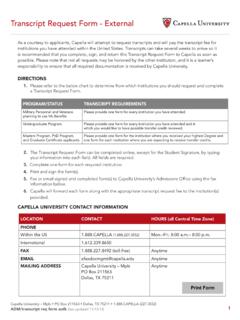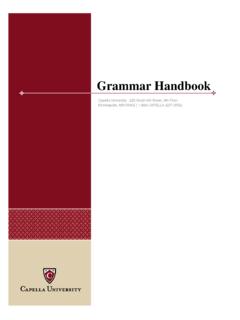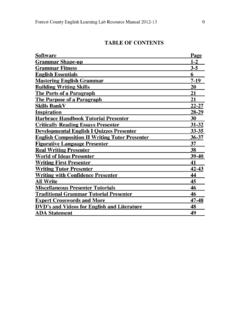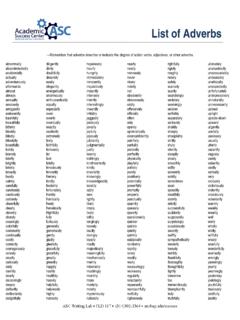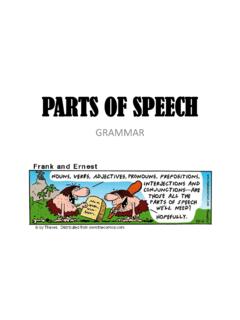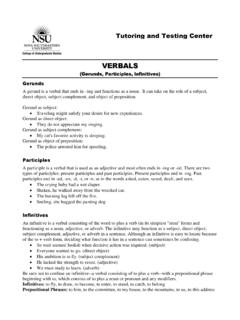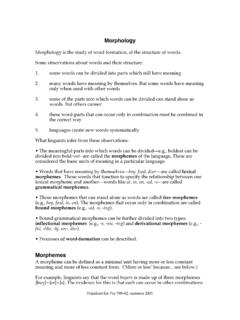Transcription of Grammar Handbook - Capella University
1 Grammar Handbook Capella University | 225 South 6th Street, 9th Floor Minneapolis, MN 55402 | 1-888- Capella (227-3552). Grammar Handbook Table of Contents 3. Sentence Basics .. 4. Sentence 19. Paragraph 25. Word Choice .. 34. 47. Mechanics .. 69. 2. Grammar Handbook Introduction Many types of languages are used throughout the world to communicate daily our countless ideas, beliefs, intentions, actions and feelings. And with mass media and the Internet, this interaction is occurring faster and more frequently with every passing second. Even specialized languages, such as mathematics and computer programming, are being used more often in an effort to create much desired and needed new processes and systems and to educate people. Therefore, as members of a growing global village encompassed by our dynamic information age, good language expression, usage, and comprehension are vital not only for accurately communicating with each other in many different ways and on many different levels, but also for correctly communicating with and managing our machines, structures and other synthetic systems as well as the organic systems we've inherited.
2 Like most of the systems in the world and universe in which we live, languages are organic and continuously evolving systems within larger changing systems, such as our local, national and international communities. Within all languages, cultural traditions and conventions have shaped, organized, re-organized and normalized language subsystems, thereby, structuring overall language systems. So like culture, itself, language is ever-developing as conventions and traditional systems are forever challenged and language structure is permanently altered. Besides the inherent ever-evolving nature of languages, in a global information age much can be lost in translation between different languages and in the inevitable meshing of cultures. Therefore, information dissemination and comprehension can be a challenge.
3 However, as with many organic systems and their subsystems, chaos is a natural part of cycles, and in an all- encompassing global and ever-changing technological environment, as cultures and languages collide, they also merge to become one. 3. Grammar Handbook Sentence Basics Parts of Speech Parts of speech are sentence elements that work together to make up a sentence. Just as a car is not a functioning car without all of its synchronized parts working together, a sentence is not a functioning sentence without the correct usage and combination of its essential parts of speech. The difference is that not all basic sentence parts or parts of speech have to be included all of the time to actually make up a complete and functioning sentence, but its parts do have to work together accurately for a writer to convey his or her intended ideas.
4 The basic parts of speech include: Noun, Pronoun, Verb, Adjective, Adverb, Preposition, and Article. Nouns A noun is a word describing who or what in a sentence it can be a person, place or thing. Remember, a thing can be anything an animal, a device, a point, an object, an event, and so on. A noun is usually an essential part of any basic sentence. It's typically who or what the sentence is about, but other nouns are often also included in longer or more complex sentences. Noun Examples: o Larry smiled. o Larry smiled at Isabel, Kevin, and their two dogs, Trevor and Lance. o Trevor and Lance were watching a show on Animal Planet. o Alaska is home to many interesting creatures. o That plain red wooden chair in the corner is a priceless antique. o The iceberg was massive underneath the water.
5 O Austin, Texas is known as the Live Music Capital of the World, i but the New York Times created controversy when it referred to it as the Live Music Capital of the South. ii A proper noun names a particular person, place or thing, and the first letter of a proper noun is always capitalized. From the examples listed above, Larry, Isabel, Kevin, Trevor, Lance, Animal Planet, Alaska, Austin, Texas, Live Music Capital of the World, New York Times, and Live Music Capital of the South are all proper nouns. Common nouns are not specific and don't require capitalization. From the examples listed above, dogs, show, creatures, chair, corner, antique, iceberg, and water are all common nouns. 4. Grammar Handbook Pronouns Pronouns can be used in place of nouns (when appropriate), and a pronoun operates just like a noun in a sentence.
6 It's important to remember, however, to use pronouns carefully. Often times, writers make the mistake of referring to a noun with a pronoun without first providing and introducing the actual noun a pronoun is replacing. This creates confusion for readers since it's then not clear who or what a pronoun is referring to. Also, once introduced, nouns should be mentioned again here and there throughout a paragraph to remind readers of the name or title of a noun (or noun phrase) even if it's only a common noun, such as philosophy student or kitten.. Nouns should be renamed even more often when many different nouns are being talked about in the same paragraph, especially when writers are describing interaction between characters or objects , He swore to her he would never deceive her again even though she was the one who had first lied to him about it after he told her what the other man told him she said.
7 How many people are being referred to in the previous sentence? When starting a new paragraph, it's also a good idea to re-introduce a noun in the first sentence since readers typically look for a change in thought or direction in a new paragraph. On the other hand, it is a good idea to use plenty of pronouns intermittently throughout paragraphs to replace nouns (once they've been introduced) so that all sentences don't begin exactly the same or follow the exact same pattern each time. Sentences may start to sound redundant or choppy (and sometimes boring) when they're all the same and become very predictable to readers. Without sacrificing meaning and direction in your paragraphs, it's good to mix it up a bit with sentences. Personal pronouns tend to come to mind first when we think about pronouns.
8 It's because most people use them a lot in their writing, and most writers instinctively know to use personal pronouns when referring to people or things even if they're not always sure when or how often to use them. The main thing to remember about personal pronoun usage is that it is based on number, person and gender. However, with the factor, gender, a lot has changed over the years in English language usage when it comes to the political correctness (PC) of referring to a person by their gender. It's something to keep in mind when writing since the main change has to do with writers no longer automatically referring to an anonymous someone as he or him. For instance: A baseball pitcher must work constantly on the accuracy of his pitch. How do we know the pitcher isn't female?
9 So, it's better to replace the word his with either his or her or with the word their. Even though their is typically known as a plural 5. Grammar Handbook personal pronoun, it has now become an acceptable and gender-neutral way to refer to someone: A baseball pitcher must work constantly on their pitch.. (More information on gender can be found in the Sexist Language section under Word Choice in this Handbook .). Another thing to remember about personal pronouns is that when writers use certain statements or commands, such as Stop!' or Listen to me! the personal pronoun you is implied You stop! or You listen to me! . Personal Pronouns Person Number Singular Plural 1st Person I (my, me) we (our, us). 2nd Person you (your, you) you (your, you). 3rd Person he (his, him). she (her, her) they (their, them).
10 It (its, it). iii Personal Pronoun Examples: o He smiled at them, but I wish he would also smile at me. o You gave me your new recipe, so of course my lasagna tastes great. o Today, they watched it until she arrived; you will have to watch it all day tomorrow. o A philosophy student spends a lot of time writing papers for his or her courses. o A law student spends hours studying their law books. (gender-neutral). o They gave him to us yesterday, and we are really enjoying our new kitten. o Its name is Sunflower. Note: In most of the examples above, it's not always clear who or what the sentence is about (besides a pronoun of some type). That's why it's important for a writer to make sure readers always know who or what is being referred to before using a huge splattering of personal pronouns to replace nouns in a paragraph.








